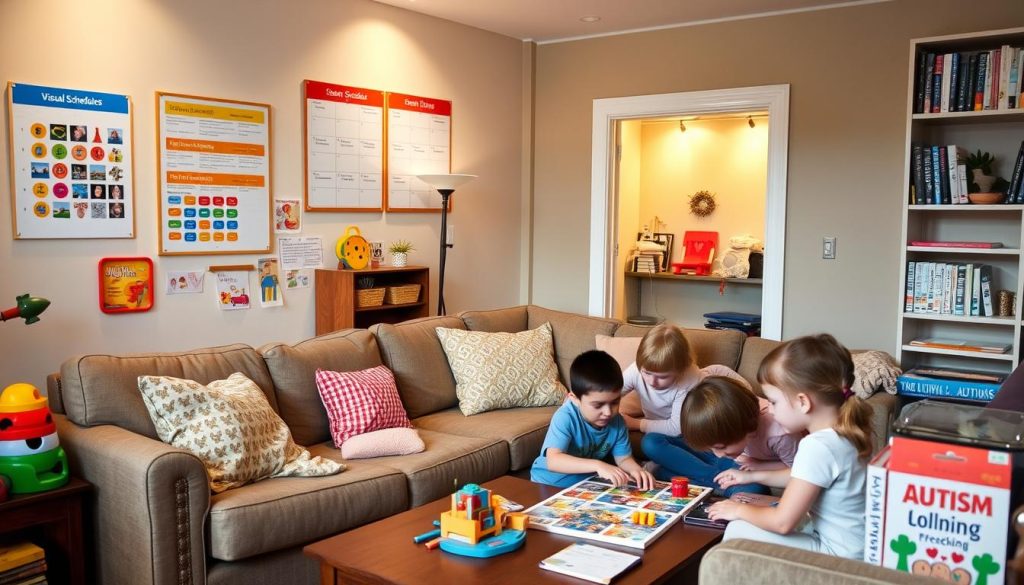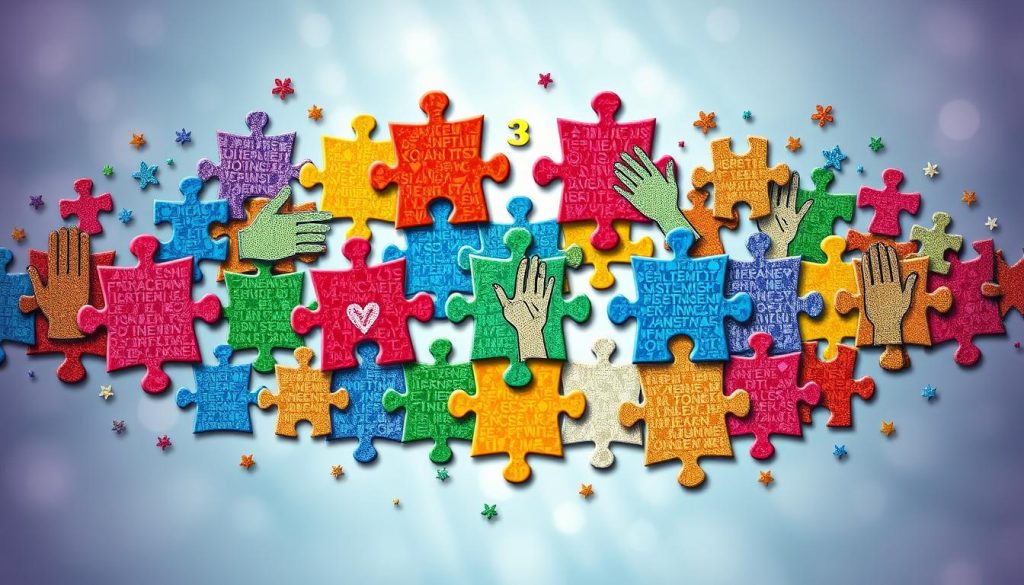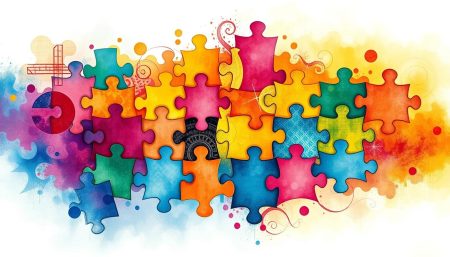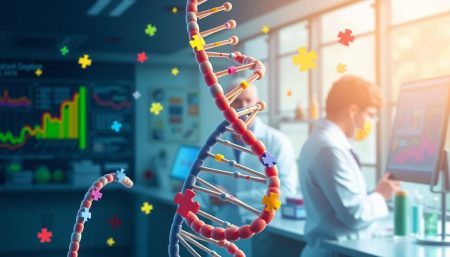Starting to understand autism spectrum disorder people is a journey filled with diversity and challenge. The world of those with autism spectrum disorder (ASD) is complex and unique. It’s important to listen to the voices of the autism community for real insights into ASD.
“Understanding ASD is not just about knowing the symptoms; it’s about recognizing the person behind the diagnosis,” says Dr. Elizabeth Torres, a renowned expert in the field. Her work highlights the need for personalized support and awareness of the spectrum’s range. This introduction aims to deepen our understanding of autism spectrum disorder people, promoting a society that values diversity.
What is Autism Spectrum Disorder (ASD)?
Autism Spectrum Disorder (ASD) is a complex condition that starts in early childhood. It affects how people interact, communicate, and behave. It shows up in different ways and can be more or less severe.
People with ASD often have trouble with social interactions. They might repeat certain actions or stick to routines very closely. This condition is a big part of neurodiversity.
Neurodiversity is about accepting and valuing different brain types. It’s about seeing neurodiverse conditions as natural, not something to fix. This view is key when we talk about living with autism.
The DSM-5 has rules for diagnosing ASD. It looks for problems with social interaction and communication. These issues must be there from the start and affect daily life.
Studies from places like the Centers for Disease Control and Prevention (CDC) show ASD is more common than before. This highlights the need for better support and understanding. It also shows we need to be more inclusive, accepting all kinds of neurological differences, including ASD.
As we learn more about ASD, society is becoming more accepting. This shift helps improve life for those living with autism. It focuses on their strengths and what makes them special, not just their challenges.
The Autism Spectrum: Variability and Individuality
Our understanding of autism spectrum disorder (ASD) has grown a lot. We now see that it affects people in many different ways. This section explores the unique traits of those with autism, showing how complex and varied the autism community is.
Characteristics Across the Spectrum
ASD shows a wide range of symptoms and abilities. Some people with autism might speak very well, while others may not speak at all. Some have amazing talents in music, math, or art, known as ‘savant’ abilities.
These differences show that autism is not a simple spectrum. It’s not just about being ‘high-functioning’ or ‘severe.’
The Misconception of a Linear Spectrum
Many people think of the autism spectrum as a straight line from ‘mild’ to ‘severe.’ But this is a big oversimplification. It’s more like a complex space where people show different traits in different ways.
By challenging this idea, we can better understand and appreciate the diversity of the autism community.
Let’s look at some examples of traits in autism spectrum disorder people:
| Traits | Low Need (Previously High-Functioning) | High Need (Previously Severe) |
|---|---|---|
| Communication Skills | Verbal, potentially fluent | Limited or non-verbal |
| Social Interaction | May struggle with social cues but can form relationships | Significant challenges in social situations |
| Repetitive Behaviors | Mild or less noticeable | More pronounced, can be disruptive |
| Response to Change | Flexible, can cope with minor changes | Highly dependent on routine, struggles with change |
Knowing these differences helps us provide better support and understanding. It makes us see the autism community in a more nuanced way.
Signs and Symptoms of ASD in Children
Spotting the early signs of Autism Spectrum Disorder (ASD) in kids is key for early help. This part talks about the signs and behaviors that might mean a child needs a check-up.
Early Developmental Milestones and Indicators
Every child grows at their own pace. But, some signs might point to ASD. Kids with ASD often struggle with social skills, talking, and doing things over and over. Experts say it’s important to watch for these signs:
- Lack of or delay in spoken language
- Poor eye contact and limited interest in peer interactions
- Absence of typical gestures such as pointing or waving by 12 months
- Repetitive use of language or motor manners (e.g., hand-flapping)
- Overly focused interests in specific objects
- Significant difficulty coping with changes in routine or behavior
Interpreting Behavioral Signs
Watching how young children act is important for parents and caregivers. Keeping a detailed record of these behaviors helps doctors make a correct diagnosis. This can lead to the right help for the child. Here are some behaviors to watch and record:
- Seeing how the child plays with toys and others
- Noticing odd reactions to sounds or textures
- Tracking any signs of slow language growth or trouble with non-verbal communication
- Watching for extreme upset without a clear reason
Spotting ASD early can help a lot. It’s vital for improving a child’s future. If you see these signs, talk to a doctor who knows about developmental issues.
Diagnosing Autism Spectrum Disorder
Understanding how to diagnose autism spectrum disorder is key to early help. Each step in the process helps create better support for those with autism. This is important for their well-being.
Different Diagnosis Methods
Diagnosing autism uses many tools and assessments. First, questionnaires and checklists look for early signs. Then, detailed assessments by psychologists or pediatricians are vital.
These evaluations might also include speech and language therapists or occupational therapists. This team approach helps confirm the diagnosis.
The Importance of Early Identification
Finding autism early is very important for kids. Early signs can lead to better communication and social skills. This is backed by groups like the American Academy of Pediatrics.
Early detection means better support for kids. It also sets them up for life-long support. Every step towards tailored care improves their life and helps them fit into society.
Challenges Faced by Autism Spectrum Disorder People
Living with autism brings unique challenges that differ for everyone. People with autism face many difficulties, from being sensitive to certain sounds and lights to having trouble with social interactions. It’s important to understand and talk about these challenges when we discuss autism support.
Many with autism have trouble with sensory issues. They might find certain sounds, lights, or touches too much. This can make everyday places like schools and work hard for them because they’re not always set up right.

Dealing with social situations is also tough. They might struggle to understand social clues, keep up in conversations, and make friends. This can lead to feeling lonely and anxious. That’s why we need good support that helps with social skills and building connections.
Also, people with autism might have other conditions like anxiety, depression, or ADHD. This makes everyday tasks and social interactions even harder. We need support that meets their specific needs, both for autism and for these other conditions.
But there are bigger challenges too. Stigma, discrimination, and not having enough support make things worse. These issues can stop people with autism from getting a good education, finding jobs, and making friends.
- Education and awareness programs to reduce stigma and promote inclusivity.
- Expansion of accessible autism support resources tailored to diverse needs across the autism spectrum.
- Legislation to ensure better accommodation and support in educational and professional settings.
Living with autism is tough, but with the right support, people can have happy lives. Recognizing and tackling these challenges is key to creating a more welcoming world.
Lived Experiences: Stories from the Autism Community
We explore the personal stories that show us what life is like for those with autism. Hearing from people with ASD gives us deep insights into how they live their lives. It shows us the many ways people deal with autism every day.
Understanding ASD Through Personal Narratives
Every story from the autism community adds to a big picture of life with ASD. These tales share the ups and downs and special views of those who live with autism. They help us understand ASD better.
Day-to-Day Life and Coping Strategies
People with autism find their own ways to handle daily life. They use things like sensory tricks and routines to make life better. These methods are key to improving life for those with ASD.
- Sensory-friendly places help them stay focused and feel at ease.
- Having a set routine helps them deal with the unknown.
- Visual tools help with talking and managing daily tasks.
By sharing these ways, the autism community helps us understand ASD better. It creates a space where people with autism can succeed in their own way.
Autism Spectrum Disorder in Adults
Autism spectrum disorder (ASD) in adults is about ongoing support and community integration. It’s important to understand the unique needs of autistic adults. This helps provide tailored support that promotes independence and community engagement.
Recognizing Adult Diagnosis and Support
Identifying ASD in adults can be challenging. Some people may not get diagnosed until they’re adults. This requires specific support resources for adults, helping them understand their identity and navigate different areas of life.
Support for autistic adults includes therapy, life skills training, and job help. These resources help reduce daily challenges and improve well-being. Local centers and online platforms offer vital support, like workshops and social groups, for adult integration and skill development.
Transitioning to Independent Living
Transitioning to independent living is a big step for autistic adults. It means being able to do daily tasks on your own and thrive in the community. Life skills, like managing money and communicating, are key.
Many autistic adults have achieved great things with the right support. They’ve lived independently, gone to college, had successful careers, and formed meaningful relationships. These stories highlight the need for accessible support resources to help with these transitions.
| Support Resource | Description | Impact |
|---|---|---|
| Job Coaching | Personalized coaching at workplace | Improves employment outcomes |
| Financial Planning Workshops | Workshops teaching budgeting and financial management | Enhances autonomy in financial decisions |
| Social Skills Groups | Group sessions to improve social interaction | Increases community engagement |
| Individual Therapy | Personalized psychological support | Supports mental health and personal development |
Therapies and Interventions for ASD Individuals
The journey of understanding ASD and finding effective therapies is complex. It involves many tailored interventions that improve life quality and abilities. It’s vital to use a wide range of autism support resources. These are key for both individuals and caregivers to face ASD challenges.
Every therapy is made just for the person, focusing on their unique needs and strengths. This shows how important it is to have specific treatment plans. There are many treatments available, from behavioral to speech and occupational therapy. Let’s explore some of the most effective ones:
- Behavioral therapies like Applied Behavioral Analysis (ABA) help improve positive behaviors and reduce negative ones.
- Speech and language therapy helps with communication challenges, making it easier to understand and express oneself.
- Occupational therapy enhances daily living skills by improving motor skills and teaching self-care strategies.
The field of autism therapies is always growing, thanks to research and feedback from the autism community. This shows how dynamic and effective autism support resources can be.
| Therapy Type | Core Focus | Typical Outcomes |
|---|---|---|
| Behavioral | Behavior Modification | Improved Social Skills |
| Speech | Communication Skills | Enhanced Expression and Comprehension |
| Occupational | Sensory and Motor Skills | Increased Independence |
To get the most from these therapies, teamwork is key. Healthcare providers, educators, and families must work together. By using personalized therapy plans, we can better support those with ASD.
Educational Strategies for Students on the Autism Spectrum
Improving education for students with autism means using special teaching methods and practices. A good approach combines making learning accessible and using effective strategies. This section will look at different techniques and resources that make learning better for students with autism.
Inclusive Education and Classroom Accommodations
Inclusive education helps students with autism do well. It includes making classrooms quiet and free from distractions. This lets them focus better. Visual aids and technology also help students learn in their own way.
Tailoring Learning to ASD Student Needs
It’s important to know and meet the learning needs of students with ASD. This means creating plans that fit each student’s abilities. It also means using clear instructions and routines to make learning easier.
Encouraging students to work together helps them learn social skills. Teachers with autism training are key in helping students. They make sure each student gets the support they need.
Getting parents involved in education is also important. It makes learning consistent and supportive at home and school. This teamwork improves the learning experience and supports students’ growth.
Using these special strategies and resources is essential. It helps students with autism reach their academic and social goals.
The Role of Family in Supporting ASD Individuals
Family is very important in supporting people with Autism Spectrum Disorder (ASD). They help create a supportive environment for growth and understanding. Family members play a big role in daily routines and emotional support, improving the life of ASD individuals.
Supporting someone with ASD is more than just love and care. It requires effort and access to resources that meet their unique needs.
Creating a Supportive Home Environment
It’s important to understand the sensory needs of ASD individuals. A home environment that is calm and free from distractions is best. Using soft colors and creating areas for play or relaxation helps a lot.
This setup reduces anxiety and supports cognitive function and well-being.
Resources and Tips for Families and Caregivers
Families need the right resources to support ASD individuals. Books, websites, and support groups are key for caregivers. They help with communication, independence, daily skills, and emotional bonds.
| Aspect of Support | Resource Type | Description |
|---|---|---|
| Daily Living | Books | Guides and manuals with advice on daily routines and life skills. |
| Emotional Support | Support Groups | Communities and forums for shared experiences and coping strategies. |
| Education | Websites | Online platforms with educational resources for ASD individuals. |
In conclusion, creating a supportive and understanding family environment is key. Using autism support resources helps families navigate autism challenges. This promotes a thriving environment for everyone.

Neurodiversity and Its Significance in Understanding ASD
The idea of neurodiversity is key in today’s views on autism spectrum awareness. It changes how we see brain development, saying that differences like Autism Spectrum Disorder (ASD) are natural and important. This new way of thinking helps us be more welcoming in education, employment, and social inclusion.
Experts say that accepting neurodiversity can greatly improve support for those with autism. It helps them understand and fit into society better. For more on the difference between mental health and conditions like ASD, check out this article on neurodiversity.
Here are some ways embracing neurodiversity boosts autism spectrum awareness and inclusion:
- It promotes special teaching methods that respect different ways of learning.
- Workplaces become more welcoming by adapting to diverse needs.
- Media and advocacy help spread understanding and acceptance.
The table below shows the benefits of recognizing and supporting neurodiversity. It highlights how it positively affects those on the autism spectrum:
| Area of Impact | Benefits of Embracing Neurodiversity |
|---|---|
| Education | Curriculums that fit different learning styles, making learning better for everyone. |
| Workplace | Workplaces that use unique strengths, leading to more productivity and happiness. |
| Social Dynamics | Less stigma and more meaningful community interactions through better understanding. |
Recognizing neurodiversity is vital for those with ASD and for society. The push for more autism spectrum awareness creates a world that values and celebrates different minds.
Incorporating Autism Support Resources in Daily Life
Living with autism and finding ways to use support resources every day can really improve life. These resources, both local and online, provide help, information, and a sense of community. They are essential for those on the autism spectrum.
Local and Online Support Groups
Support groups, both local and online, are great for sharing experiences and learning new ways to live with autism. Local groups meet up, hold workshops, and have social events. This helps people feel connected and supported. Online groups, on the other hand, reach more people, providing a place for empathy and understanding at any time.
Navigating Healthcare and Education Systems
It’s important to know how to work with healthcare and education systems to get the support you need. This means understanding how to talk to professionals, asking the right questions, and knowing your rights. Working with schools to meet the needs of students with autism requires ongoing communication with teachers and administrators.
| Resource Type | Benefits | Challenges |
|---|---|---|
| Local Community Groups | Immediate, localized support and the building of long-term relationships | Varied availability depending on location |
| Online Forums | 24/7 availability, access to a wide network | Needs internet access, varying levels of moderation |
| Healthcare Navigation | Access to tailored healthcare strategies and interventions | Complex system navigation and insurance hurdles |
| Educational Support | Specially tailored educational programs and accommodations | Requires regular monitoring and advocacy |
By using autism support resources, individuals and families can make living with autism better. This allows everyone to have a fulfilling and enriched life. It also helps the community understand the challenges and opportunities for those on the autism spectrum.
Celebrating Successes within the Autism Spectrum Community
The achievements in the autism community show the strength and ability of those on the spectrum. These successes help raise awareness and give hope to others on similar paths.
Achievements and Positive Outcomes
People with autism are making great strides in school and work. They reach high goals thanks to special programs and work places that support them.
The Power of Community and Shared Experiences
Community support is key to these achievements. Sharing experiences builds a network of support and understanding. It helps people reach their goals and fights for more inclusion.
| Accomplishment | Contributing Factors | Community Impact |
|---|---|---|
| Graduation Rates Increase | Specialized Educational Programs | Raised Educational Standards |
| Employment in Tech Sector | Corporate Inclusivity Initiatives | Broader Career Opportunities |
| Artistic Achievements | Supportive Art Communities | Cultural Enrichment |
The progress made by the autism community is truly inspiring. Each success shows what’s possible with support and inclusivity in all areas of life.
Advances in Autism Spectrum Awareness and Research
Recent years have seen big steps forward in autism spectrum awareness and research. Studies have been key in finding ways to detect and help ASD individuals early on. This has greatly improved how we understand and support them.
Genetics research has been a major highlight. Scientists have found specific genes linked to autism. This helps doctors diagnose better and tailor treatments to each person’s needs.
There’s also been a big jump in autism spectrum awareness. This awareness has led to a more welcoming world for those with ASD. Schools, workplaces, and communities are now more ready to support them.
| Year | Breakthrough | Impact |
|---|---|---|
| 2018 | Identification of new genetic markers | Enhanced early detection and personalized treatment plans |
| 2020 | Development of neurodiverse teaching strategies | Improved educational outcomes for ASD students |
| 2022 | Launch of global autism awareness campaigns | Increased public understanding and acceptance |
The future looks bright for ASD individuals with ongoing research and new therapies. Technology, like AI, is set to change how we help those on the autism spectrum. These advancements promise to make a big difference in their lives.
Legal Protections and Advocacy for Autistic Adults
In recent years, big steps have been taken to protect autistic individuals in the workplace and schools. Laws now help ensure autistic adults get fair chances and are safe from unfair treatment.
Understanding Rights and Accommodations at the Workplace
Workplace changes are key for autistic adults. These might include flexible hours, quiet spaces, or tools to help with communication. Employers must offer these changes to make sure everyone feels welcome and supported at work.
Engagement in Policy Change and Legal Support
Advocacy groups are very important for autistic adults. They help people understand their rights and deal with legal issues. These groups also work with lawmakers to make sure autistic adults are included in society.
| Protection | Description | Impact |
|---|---|---|
| Employment Non-Discrimination | Legal mandates that prevent workplace discrimination based on autism | Enhances job access and retention for autistic individuals |
| Reasonable Accommodations | Adjustments or modifications provided in the workplace to support the specific needs of autistic employees | Improves work performance and satisfaction among autistic adults |
| Legal Advocacy | Support services from advocacy groups to navigate legal challenges | Empowers autistic individuals to participate fully and equally in society |
Towards an Understanding Society: Promoting Autism Awareness
In our journey towards fostering autism spectrum awareness and understanding ASD, the role of educational initiatives and media portrayal cannot be overstated. As we explore these approaches, we gain insights into how widespread knowledge and acceptance are being molded by proactive community measures and media narratives.
Educational Campaigns and Community Efforts
Community campaigns and educational outreach play a big role in raising autism spectrum awareness. These efforts not only inform the public but also engage them in meaningful ways to support individuals with ASD. Various organizations have spearheaded initiatives that enhance understanding ASD through seminars, workshops, and inclusive activities, bringing to light the diverse experiences of those on the autism spectrum.
Media Portrayals and Their Impact on Public Perception
The influence of media on society’s view of autism spectrum disorders is profound. Through films, television shows, and news reports, the media shapes how autism is understood and perceived. Analyzing these portrayals offers a window into the progress toward sensitivity and accuracy, as well as the persistent challenges in depicting the true diversity within the autism community.
| Media Type | Portrayal Impact | Examples |
|---|---|---|
| Films | Often oversimplified, sometimes insightful | Rain Man, Temple Grandin |
| TV Shows | Mixed – ranging from stereotypical to complex characters | Atypical, The Good Doctor |
| News Media | Focused on breakthroughs and individual stories | Feature segments on networks like CNN, BBC |
Understanding how these different media types affect public perception helps guide future strategies in autism spectrum awareness campaigns.
Living with Autism: Acceptance and Adaptation
The journey of living with autism is unique for each autism spectrum disorder person. It involves learning, adjusting, and growing. Acceptance is key, from self-acceptance to acceptance by family, friends, and the community.
When society values neurodiversity, it creates a place where differences are celebrated. This allows individuals on the spectrum to live full and meaningful lives.
Adaptation is vital for those with autism, requiring resilience and resourcefulness. Strategies include structured routines, sensory-friendly environments, and personalized learning. These must fit each individual’s needs and strengths.
Through adaptation, society can become more inclusive. This allows those with ASD to show their abilities and make contributions.
Living with autism is a journey of personal and societal integration. It involves advocacy, education, and policy changes to improve access for those with ASD. By sharing successes and challenges, we highlight the need for a society that adapts to its neurodiverse members.
The goal is a future where everyone can reach their full capacity, regardless of neurotypical standards.
FAQ
Q: What exactly is Autism Spectrum Disorder (ASD)?
A: Autism Spectrum Disorder (ASD) is a complex developmental disability. It has a wide range of symptoms and severity. People with ASD often struggle with social communication and have repetitive behaviors or interests.
Understanding ASD is key to seeing the diversity within the autism community. It falls under the concept of neurodiversity.
Q: How does the autism spectrum demonstrate variability and individuality?
A: The autism spectrum shows a wide range of abilities and challenges. Some people with ASD need a lot of support for daily tasks. Others may live independently and excel in certain areas.
The term “spectrum” highlights the diversity in the autism community. It shows that each person with ASD is unique.
Q: What are some of the signs and symptoms of ASD in children?
A: Early signs of ASD in children include not responding to their name and limited eye contact. They might struggle with back-and-forth play and communication. They may also have repetitive movements or play.
Every child shows these signs differently. That’s why early identification and support are so important for parents and caregivers.
Q: Can adults be diagnosed with ASD?
A: Yes, adults can be diagnosed with ASD. Some may get diagnosed later in life. Their experiences and needs can be different from those diagnosed as children.
There are support resources for autistic adults. These programs focus on independence, community integration, and tailored support for a fulfilling life.
Q: What therapies and interventions are available for ASD individuals?
A: Many therapies and interventions are available for ASD individuals. These include behavioral, speech, occupational, and educational interventions. Tailoring these therapies to each person’s needs is key to supporting their growth.
Understanding ASD and its impact helps in creating personalized plans. This approach is essential for each person’s development.
Q: How does neurodiversity impact the understanding of ASD?
A: Neurodiversity recognizes and respects neurological differences as natural variations. It shifts the view on ASD from focusing on deficits to valuing diverse cognitive styles. This promotes acceptance and support for people on the autism spectrum.
Q: What role does the family play in supporting ASD individuals?
A: Families are vital in supporting ASD individuals. They create a nurturing and accommodating environment. Establishing routines and creating sensory-friendly spaces helps address unique needs.
Families also access and provide autism support resources. This ensures a collaborative approach to living with autism.
Q: What legal protections exist for autistic adults?
A: Autistic adults are protected by laws like the Americans with Disabilities Act (ADA). These laws ensure rights and accommodations in employment and education. Advocacy groups help autistic individuals understand their rights and seek support.
Q: How can society promote autism awareness and understanding?
A: Society can promote autism awareness through educational campaigns and community outreach. Accurate media portrayals also help. This fosters a more informed and accepting society.
By increasing understanding, individuals with ASD can enjoy more social inclusion, resources, and opportunities.
Q: What advances have been made in autism spectrum awareness and research?
A: Research has made significant progress in understanding ASD. This includes genetics, early detection, and personalized interventions. Increased awareness has led to better resources and acceptance for the ASD community.
Ongoing studies and initiatives continue to improve the well-being of ASD individuals.


















